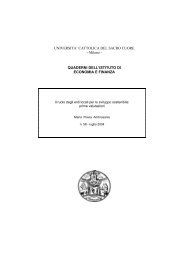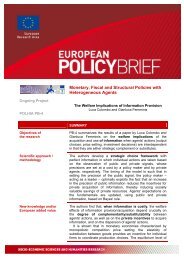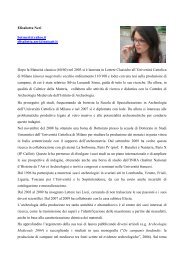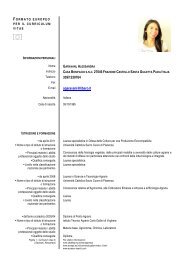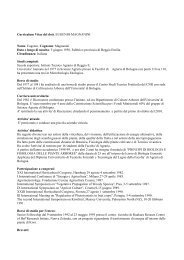UNIVERSITA' CATTOLICA DEL SACRO CUORE - Milano - Istituti
UNIVERSITA' CATTOLICA DEL SACRO CUORE - Milano - Istituti
UNIVERSITA' CATTOLICA DEL SACRO CUORE - Milano - Istituti
You also want an ePaper? Increase the reach of your titles
YUMPU automatically turns print PDFs into web optimized ePapers that Google loves.
price-caps 46 and a network cap covering interconnection and unbundling of the<br />
local loop.<br />
The introduction of the abovementioned network-cap is due to Resolution n.<br />
152/02/Cons issued on May 15, 2002 in response to a suit against Telecom Italia<br />
filed by 26 Olo, alleging price discrimination and margin squeeze 47 . To cope with<br />
this competitive concerns, the Resolution imposed current account costing and<br />
(hopefully) more effective accounting separation, requiring evidence of transfer<br />
charge and volume for each service and imposing formal audit verification 48 . To<br />
ensure the principle of non-discrimination and parity of treatment to be applied<br />
systematically with reference to both economic and technical conditions, the<br />
Resolution also imposed on Telecom Italia the formal obligation to ensure and<br />
certify the separation between the Network and Retail Unit information system;<br />
further, it impose the organizational splitting of the Wireline division into<br />
Wholesale and Retail business units. Resolution 152/02/Cons addresses the<br />
problem of cost orientation, and related problems of vertical price and margin<br />
squeeze, by adopting two price test that Rio offers have to comply with. To pass<br />
the price floor test, the offer must allow the incumbent full cost recovery; the<br />
replicability test requires the offer to be set at a level that a satisfactorily efficient<br />
competitor could achieve cost recovery 49 . Agcm supported the attempt to increase<br />
transparency and reduce uncertainty, however the two tests have been criticized<br />
on two grounds: firstly, they do not provide incentives to efficiency and thus reap<br />
neither the technical efficiency gains of the integrated incumbent nor the cost<br />
savings of entrants; secondly, the price-formation verification system appears<br />
intrinsically affected by incentives not to disclose relevant information 50 .<br />
Summing up the preceding extensive discussion of competitive and regulatory<br />
problems arising when maintaining a vertically integrated Tlc incumbent, it<br />
appears that even the utmost competent and proactive Competition and<br />
Regulatory Authorities face great difficulties in preventing and adequately<br />
punishing strategic behaviors by the incumbent. This is especially true in sectors<br />
such as Tlc, where innovation rapidly enable supra-competitive profits to be<br />
earned in new markets while at the same time making currently dominated<br />
46<br />
Namely: Access services (Rpi), with a sub-cap on residential access services (Rpi – Rpi);<br />
National calls (Rpi – Rpi); Retention of fixed to mobile calls (Rpi – 6%). On the contrary,<br />
international calls are not subject to price-caps constraints.<br />
47<br />
The following brief discussion of Resolution 152/02/Cons draws heavily on NONNO [2003].<br />
48<br />
It is now widely recognized in literature that accounting separation may only play a<br />
complementary role to other regulatory techniques. Compare HARDT [1995] and OECD [2001], p.<br />
14, § 52: “[accounting or corporate separation] affect neither the incentives nor the ability of the<br />
regulated firm to act in an anticompetitive manner. Although these forms of separation have merit<br />
in supporting other approaches, they cannot be used as stand-alone techniques in their on right”.<br />
49<br />
Indeed, Olo network costs are 20% discounted in order to provide the entrant with an incentive<br />
to build her own network.<br />
50<br />
AGCM [2002]: “In definitiva, il sistema di verifica dei prezzi in esame rischia di dar luogo ad<br />
una artificiosa protezione dei profitti di tutti gli operatori e, in quanto disincentiva gli operatori<br />
alternativi ad investire nella realizzazione di infrastrutture alternative di rete, a una<br />
cristallizzazione della struttura di mercato esistente”.<br />
15




